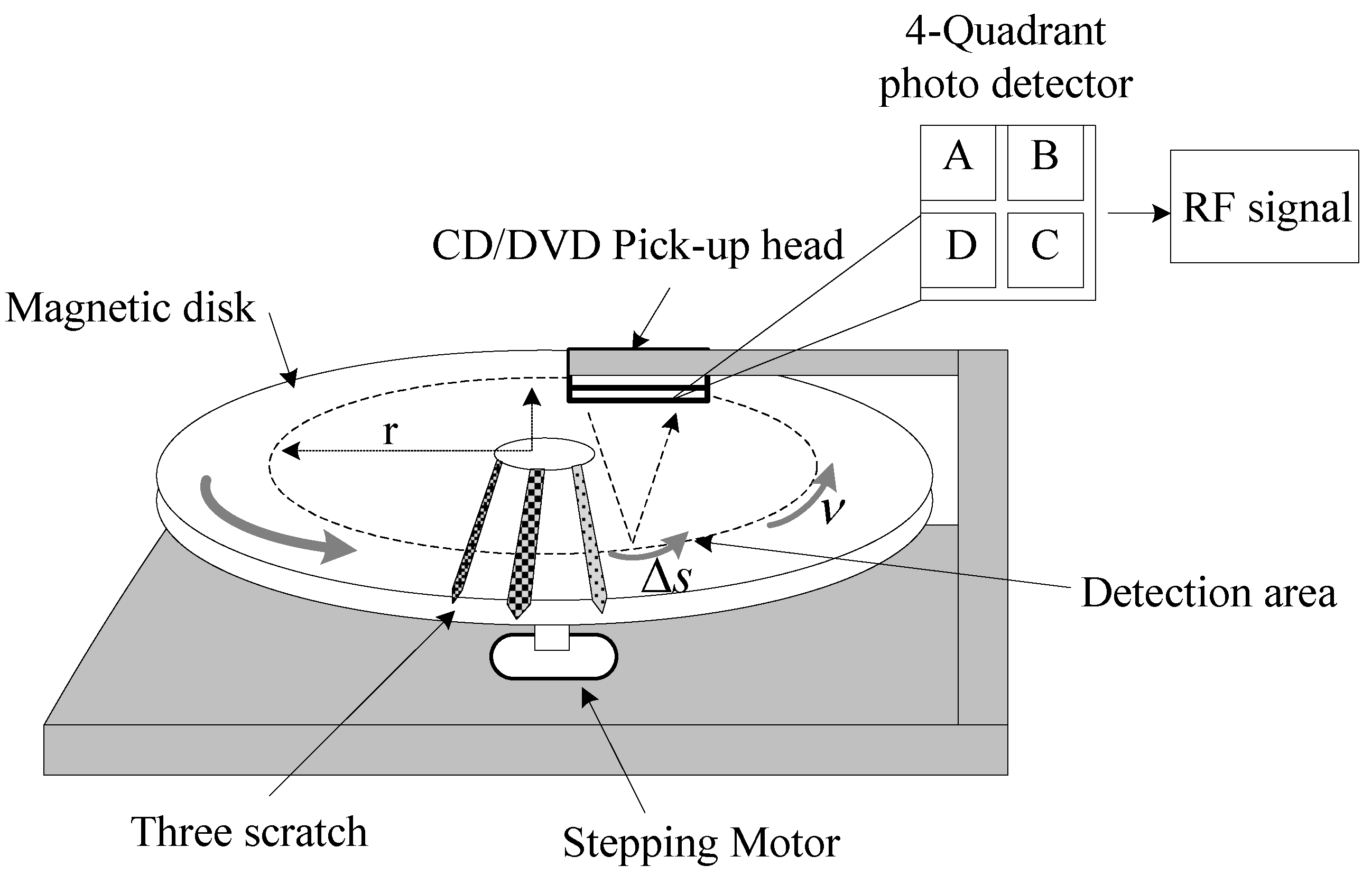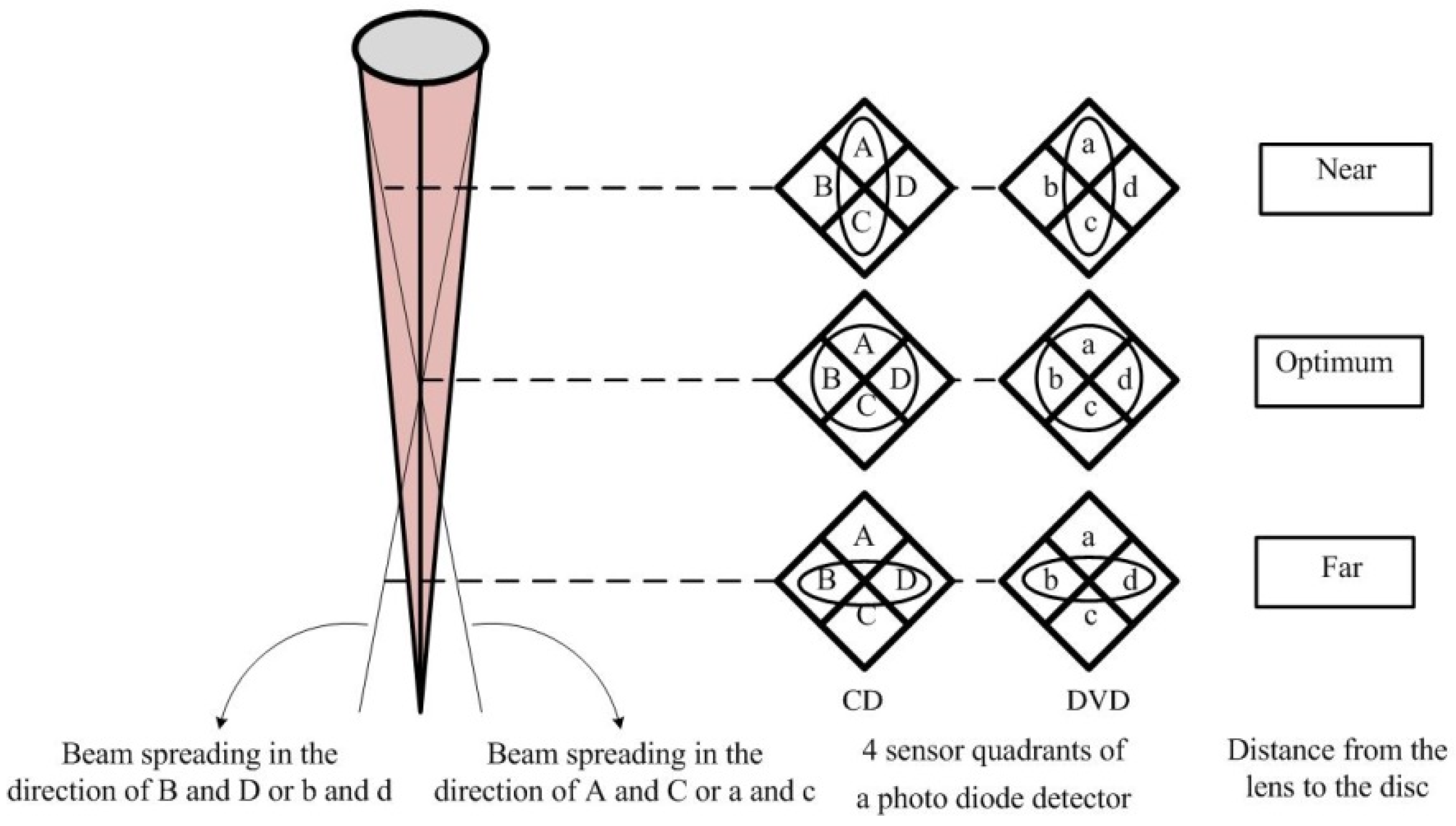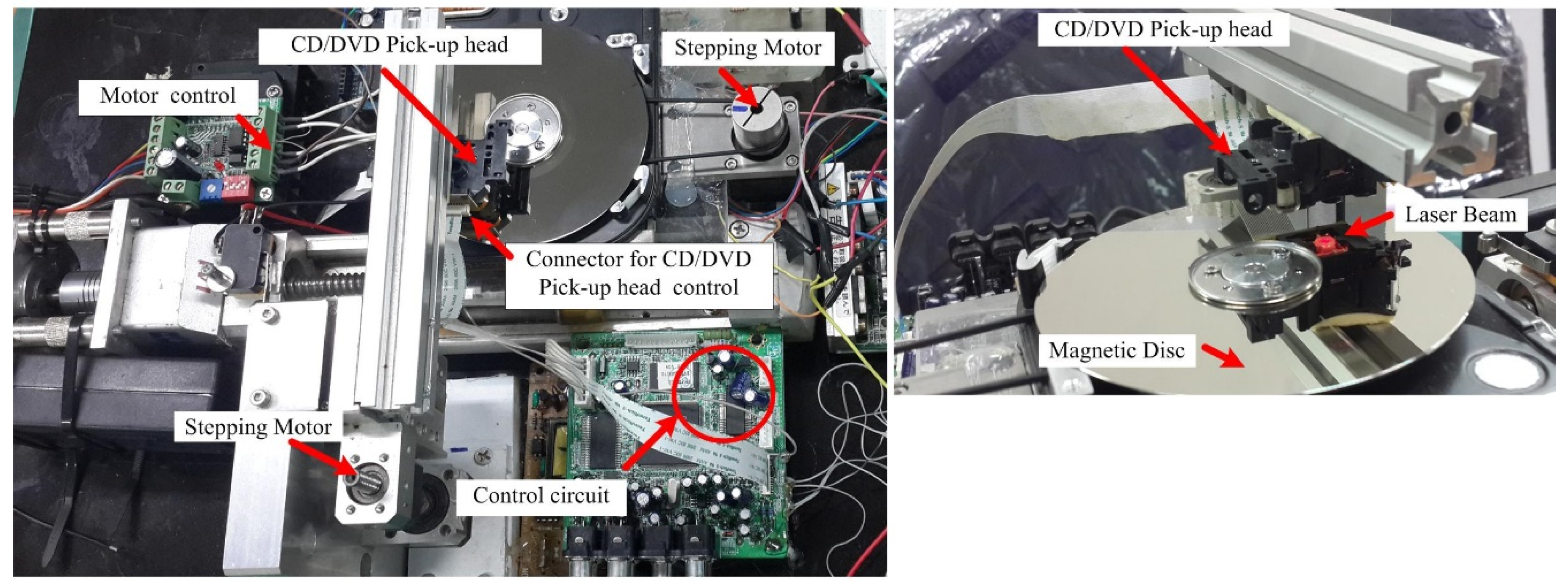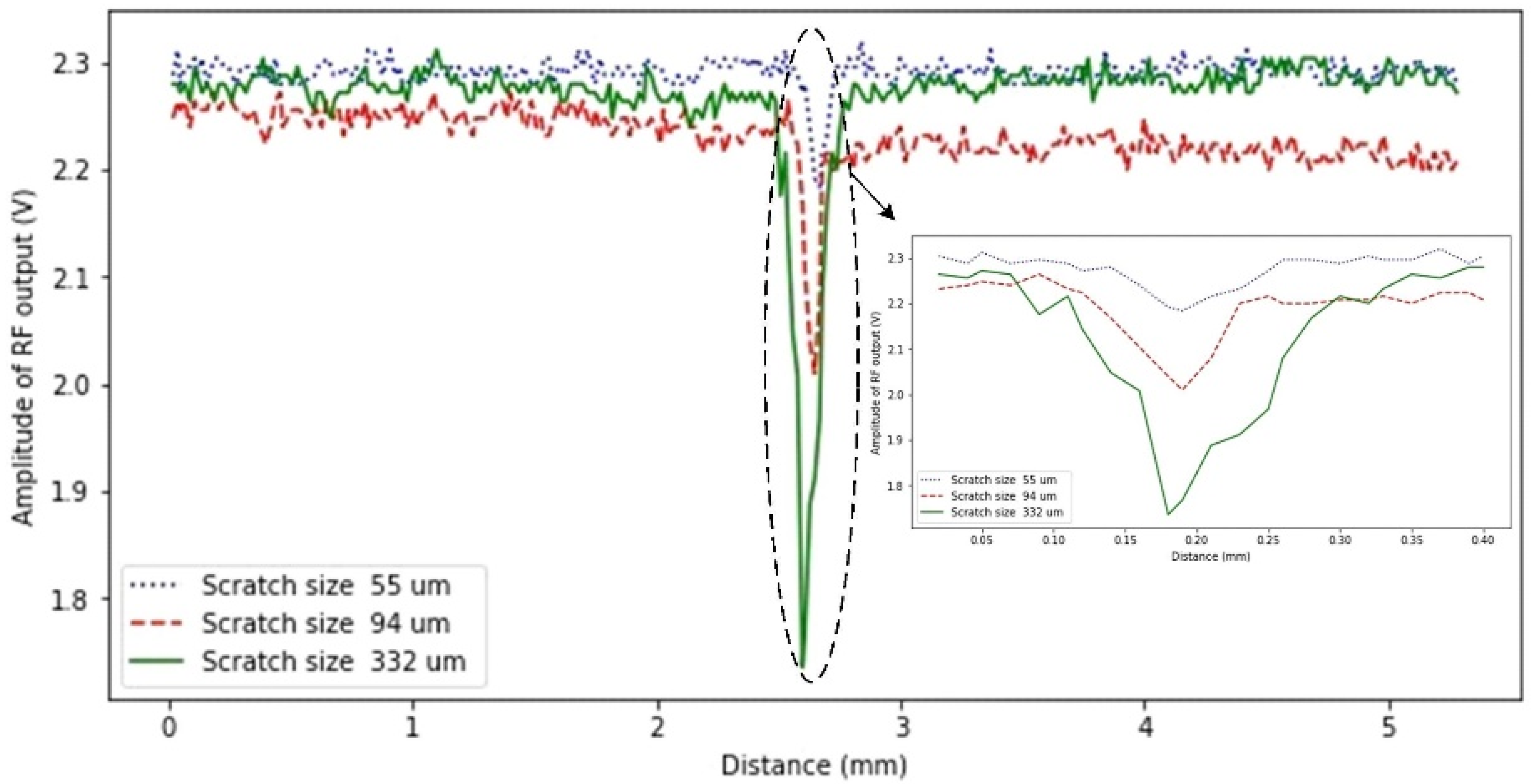1. Introduction
Scratch detection on magnetic disk is an important process of a quality inspection of hard disk drive (HDD) manufacturing because the scratches could possibly affect reading/writing performance of the HDD [
1]. Scratches mainly occur due to contamination in the HDD assembly process, or crashing between magnetic recording head and disk [
2]. Thus, the scratch inspection is a crucial process to reject latently damaged disks before further processes.
In order to detect scratches, many tools have been employed, such as scanning electron microscope (SEM) and atomic force microscope (AFM). They were introduced because of their clarified resolution for detecting a scratch and its depth by images [
3]. However, they are complicated in terms of utilization procedures and the light microscope with less complication than those proposed with a low resolution gain of about 100× [
4]. Although these three methods are surface free-contact techniques, they are expensive, destructive, and time-consuming. In order to cover up these disadvantages, the scratch inspection with a satisfied resolution in a quick process was developed using a thermal infrared camera to detect the surface heat and it was found that heat appears only on the surface, not scratch [
5]. A magnetic disk, in the real process, rotates at a certain velocity and researchers have proposed various possibilities to detect a scratch dynamically. One showed an inventory of an optical pickup unit for light reflection into the charge coupled device (CCD) with polarizers and Infrared- (IR) cut filters for intensification of the laser beam [
6]. However, for better resolution, machine vision inspection methods using various algorithms to examine the 2D surface images have also been studied but they can only be measured in static state [
7]. In addition, it is still a vast cost of investment for industry.
Therefore, a new technique of low cost, easy process, and scratch detectability has been presented by using ordinary laser doppler and CD pick-up head to inspect surface details because of its advantages on the measurement of object roughness and the identification of scratch location, in a compromising process [
8,
9]. Moreover, numerous studies have recently shown interesting results of using DVD pick-up head to detect the reflective DNA layers on a DNA chip slide as its potentiality to show the shape of the DNA and count the number of cells [
10]. The DVD pick-up head has been developed for better precision by reflecting the beam to photo detector integrated chip (PDIC), as a receiver, and then, the reflected laser light from PDIC is focused and analyzed on four quadrant sensors of photodiode detector [
11].
This study proposes a developed invention of non-destructive detection technique to inspect a 10 + µm scale of scratches on a rotating magnetic disk. The current process of scratch inspection in manufacturing randomly chooses disks and it causes failures found in further processes. The assembly processes of latent failure disks lead to the cost of operation. Therefore, this instrument can quickly inspect big scratches of all media disk and a disk with a scratch found in this beginning of the manufacturing process will be thrown away at once. The CD and DVD pick-up heads with 790 and 650 nm wavelengths, respectively, are firstly combined and developed by using PDIC to specify the position and the shape of scratches for a wide range of wavelength selection. This aims to support the invention of its ability to specify the scratch location. The shapes of scratches are also examined by SEM to verify the experimental results. The scratches of 55–332 µm size are tested because of the industrial requirement for rejection criteria. In addition, an optimistic rotating speed of magnetic disk to improve performances of CD and DVD pick-up heads has to be investigated.
2. Materials and Methods
2.1. Determination of Scratch Position and Width
The scratch position can be calculated by finding a distance (
) based on the rotating velocity (
) from a radially moving reference point on the CD/DVD pick-up head as shown in Equation (1) and
Figure 1. The distance along the circumstance is increased when the radius increases:
The scratch width is calculated from the sampling rate of a number of sampling in 1 cycle per distance as the magnetic disk movement is relative to the time. The radio frequency (RF) signal measurement is achieved by using the waveAce 2012 oscilloscope with a 40–300 MHz bandwidth and a maximum 2 GS/s sampling rate. In order to find the location of the scratch, a microcontroller will control a stepping motor to move a disk in circular axis and a pick-up head to move along the radius axis.
2.2. Focus Error Signal Technique
A laser beam, generated by the DVD pick-up head, was introduced to propagate onto a surface of the disk and then, reflected to a portion of 4 quadrant sensors of a photodiode detector for a precise focus [
12]. However, the focal range of reflection light of the DVD pick-up head covers more than one quadrant of the photodiode detector and the focus error signal (FES) technique was proposed [
13].
A CD pick-up head with different wavelength is firstly, in this paper, combined with the DVD pickup head for not only making a comparison but also, increasing the ranges of wavelength or scratch details. In order to overcome the misalignment problem between focal distances of the reflection light, the technique of focus error signals (FES) is then developed as shown in
Figure 2 and following Equations (2) and (3) for CD/DVD modes. The symbolic modes of the CD/DVD are sets of A, B, C, D and of a, b, c, d, respectively.
2.3. RF Amplifier of Signals
However, the output signal is too small to be analyzed and so, an amplifier circuit has to be designed. In addition, for further enhancement of signal amplitude, the RF amplifier circuit is extended to transform a light signal from four photodiode detectors to four current signals. The technique is then developed to integrate the signals by using the RF summing amplifier circuit, as shown in
Figure 3 and Equations (4) and (5) for the CD/DVD set, respectively.
Since the wavelength of CD, 790 nm, is larger than that of DVD, 650 nm, the photodiode detectors are chosen to automatically switch a laser beam of two different wavelength modes. The specifications of CD and DVD pick-up heads are compared in
Table 1.
2.4. Design of Microcontroller
Since the industrial inspection process is normally run in dynamic state, a rotating magnetic disk is to be controlled by using the microcontroller. This is firstly designed to fit the requirement of the industrial procedure by adapting an advanced RISC machine (ARM) Atmel, ATmega328P microprocessor to control rotating stepping motor and pick-up heads as shown in
Figure 4.
2.5. Verification of Scratch Size Detection and Characterization
In order to confirm the experimental results of scratch detection done by this proposed technique, the SM and SEM are performed to characterize scratches. These two techniques have to be done in the last process of this study because the magnetic disk must be destroyed. The SM with 8–40× magnification is used to scan the visible scratches, while the SEM (JEOL No. JSM-6010LA) with 5–300,000× magnification at 400–700 nm wavelength is used to measure the size and shape of scratches.
3. Experimental Setup
This study presents a newly invented experimental setup by using a microcontroller for controlling the rotating velocity of a magnetic disk in order to precisely detect the position and width of the scratch. A combined CD/DVD pick-up head is firstly initiated with the developed FES technique for either comparison study or more wavelength selection/scratch-width detectability. The PDIC technique is also adapted to gain precision of focal range. In order to obtain a clarified signal, an amplifier system has also been improved.
The block diagram of this experiment is shown in
Figure 5 and its real experimental setup shown in
Figure 6. It is composed of the 2014-Sanyo SF-HD65 model of CD/DVD pick-up heads equipped with a stepping motor and its controller, a set of four quadrant photo sensors and a set of photodiode detectors, an RF amplifier circuit, and an RF summing amplifier circuit.
It is seen that a 2.5 inch magnetic disk is placed on a 1500 rpm stepping motor and controlled by our newly designed microcontroller. A light beam of red light of 650 or 790 nm wavelengths is generated by the CD or DVD pick-up head, respectively, and then reflected deliberately from a disk onto a certain portion of four quadrants of photo detectors or sensors. The 4-photodiodes will then choose the signals of the CD or DVD and be amplified by the RF amplifier and integrated by the summing amplifier.
The laser diode (LD) part requires a 35 mA operating current and a 4.5–5.5 V driving voltage. An RF amplifier works at a 2.15–5.00 V input signal. The focus areas of the lens of the CD and DVD pickup heads are 0.47 and 0.6 mm, respectively. The working distance (WD) of the CD and DVD pick-up heads are set at an appropriate range of 1.30 and 1.67 mm and its focal distance of 3.05 and 3.07 mm, respectively.
4. Results and Discussion
4.1. Comparison of Scratch Measurements of CD, DVD and SM with Refereed SEM
Three deliberated scratches of about 55, 94, and 332 μm are marked on a controllable rotating disk. The RF output of the CD/DVD pick-up heads is amplified by the RF summing amplifier circuit and then, measured by the oscilloscope. The maximum recording length are 45,000 samples. The maximum optimizing numbers of sampling of the CD/DVD pick-up heads within a cycle of the rotating disk are found at 2813 and 2548, respectively, using the speed for the disc rotate at 1500 rpm.
The width and position of the scratches can be measured by the estimated number of sampling within a cycle. The scratches position is calculated as the rotating distance of the magnetic disk per sampling number within 1 cycle. It is found that the 1st, 2nd, and 3rd scratches are located on the magnetic disk at the distance of 118.07, 128.44, and 138.93 mm, respectively, from the starting point.
4.2. Comparison of Scratch Size Detected by CD Pick-Up Head, DVD Pick-Up Head and SM
The output signals of 3 different scratches detected by CD and DVD pick-up heads are shown in
Figure 7 and
Figure 8, respectively. The inset shows the magnified signal at the scratch point. The scratch size is referred to the scratch width which is later measured by SEM with magnification of 300,000×. It is seen that the widths of the 1st scratch detected by the CD and DVD pick-up heads are ~68.97 and ~68.94 μm, respectively, while those of the 2nd scratch detected by the CD and DVD pickup heads are ~110.35 and ~110.30 μm, respectively. The biggest scratch of the 3rd one is measured by the CD pick-up in an order of 337.18 μm size and the DVD pick-up head of 337.82 μm size. These results are compared with SM and SEM measurements as shown in
Table 2.
It is useful to observe the oscillation of signals detected by the CD and DVD pick-up heads to study the details of signal. It is seen in
Figure 8 that signals of the DVD pick-up head are more sensitive than those of the CD pick-up head as shown in
Figure 7. This shows that the DVD pick-up head can better detect details of the surface roughness than those of the CD pick-up head. It results in more accuracy of scratch width and characteristic.
From
Table 2, it is found that the results of CD and DVD pick-up heads tested on a rotating disk are better than those of a static SM test. The errors of about 17.39–25.40% are found satisfyingly for the DVD pick-up head and those of about 17.34–25.35% for the CD pick-up head as a scratch is under 100 μm size. However, for the biggest scratch of the 3rd one, it is clearly seen that newly invented CD/DVD pick-up heads provides an extraordinary promising result with just a few percentages of error.
Therefore, by observation of 3 sizes of marked scratches, both CD/DVD pick-up heads show better scratch characteristic and simpler position locating than those of the SM for the <100 μm scratch but for the >100 μm scratch; CD/DVD pick-up heads show a remarkably result similarly to that of SEM.
4.3. Characteristic Comparison of Scratch Detected by CD and DVD Pick-Up Heads
An important detail of the scratch needed to study is the shape characteristics and those detected by the CD pick-up head, DVD pick-up head, and SEM are essentially compared. It is seen in
Table 3 that shape characteristics of scratches detected by CD and DVD pick-up heads are similar to those measured by SEM. These 3 scratches are examined to confirm their shapes by SEM as shown in
Figure 9. The shape characteristics of the scratches detected by this proposed technique can specify the cause of scratches on magnetic disks in the hard disk manufacturing processes.
4.4. Rotating Speed and Scratch Sizes Detected by CD and DVD Pick-Up Heads
A speed variation of the rotating disk controlled by a new designed microcontroller has to be studied to find an optimistic speed for CD and DVD pick-up heads. A speed of 500–1500 rpm is varied and the results are shown in
Table 4, while the error compared to the SEM results are shown in
Figure 10.
The disk rotation speeds of 500–1500 rpm are used to detect the width of the three scratches. Then, scratches are detected by the CD/DVD pick-up head at different speeds. In
Table 4, it is shown that the measured size of scratches for both CD/DVD pic-up heads are enlarged when the rotation speed increased. The error is also increased when the velocity is fast. This is possible due to the high speed resulting in a loss of focus on the disk and the unstable easily [
14]. Thus, an optimizing scratch can be obtained at low speed of disk rotation.
5. Conclusions
The new adaptive scratch detection technique using CD and DVD pick-up heads as a proposed detector with 3 different types of scratches on the magnetic disk are measured. The light reflection technique is initially performed to identify the size, position, and shape characteristic of scratches. It is found that either the CD or DVD pick-up head can be greatly performed as the scratch detector. The size and location of the scratch can be more precisely examined by CD/DVD pick-up heads than ordinary SM. In addition, it is shown that for a large scratch, the CD/DVD pick-up heads show a very promising result refereed by SEM. However, a low speed of disk rotation is found to provide less errors. Therefore, from the results, the CD/DVD pick-up heads can be utilized to identify the location and size of the scratch on a disk-media in hard disk drive manufacturing for a quick non-destructive inspection.
Author Contributions
Conceptualization, A.P. and A.S.; methodology, A.S.; formal analysis, A.P. and A.S.; investigation, A.P.; resources, W.T.; data curation, A.P. and W.T.; writing original draft preparation, A.P.; writing-review and editing, A.S.; supervision, A.S. All authors have read and agreed to the published version of the manuscript.
Funding
This research received no external funding.
Acknowledgments
Authors would like to thank Pimai Sawangpol and Kesinee Chantharasophon from Ubon Ratchathani Rajabhat University for measurement technic, and Pairor Sangwang and Worakarn Wongsaichua from Ubon Ratchathani University for instrument support.
Conflicts of Interest
The authors declare that there is no conflict of interest regarding the publication of this paper.
References
- Odgaard, P.F.; Stoustrup, J.; Andersen, P. Detection of surface defects on compact discs. J. Control Sci. Eng. 2007, 10, 1–9. [Google Scholar] [CrossRef]
- Furukawa, M.; Xu, J.; Shimizu, Y.; Kato, Y. Scratch-induced demagnetization of perpendicular magnetic disk. IEEE Trans. Magn. 2008, 44, 3633–3636. [Google Scholar] [CrossRef]
- Russell, P.; Batchelor, D. SEM and AFM: Complementary techniques for surface investigations. Microsc. Anal. 2001, 1, 9–12. [Google Scholar]
- Hocken, R.J.; Chakraborty, N.; Brown, C. Optical metrology of surfaces. CIRP Ann. 2005, 54, 705–719. [Google Scholar] [CrossRef]
- Todtong, Y.; Kaewrawang, A.; Sivaratana, R.; Kruesubthaworn, A.; Thompson, S.M.; Siritaratiwat, A. Thermal image refinement approach for scratches on a magnetic disk evaluated at various angles. Instrum. Sci. Technol. 2013, 41, 365–381. [Google Scholar] [CrossRef]
- Wang, W.-M.; Cheng, C.-H.; Molnar, G.; Hwang, I.-S.; Huang, K.-Y.; Danzebrink, H.-U.; Hwu, E.-T. Optical imaging module for astigmatic detection system. Rev. Sci. Instrum. 2016, 87, 1–4. [Google Scholar] [CrossRef] [PubMed]
- Zhang, H.-Y.; Wang, Z.-H.; Fu, H.-Y. Automatic scratch detector for optical surface. Opt. Express 2019, 27, 20910–20927. [Google Scholar] [CrossRef] [PubMed]
- Zhu, S.; Zhou, W.; Song, Y. Detecting oscillation amplitude and defects of hard disk rotating in high speed by laser Doppler technique. Measurement 2012, 45, 74–78. [Google Scholar] [CrossRef]
- Polsawat, A.; Suwannata, N.; Siritaratiwat, A.; Kruesubthaworn, A. A Signal analysis of scratch-detection on magnetic disc by using light reflection approach. Appl. Mech. Mater. 2015, 781, 203–206. [Google Scholar] [CrossRef]
- Hwu, E.T.; Anja, B. Hacking CD/DVD/Blu-ray for Biosensing. ACS Sens. 2018, 3, 1222–1232. [Google Scholar] [CrossRef] [PubMed]
- Siaudinyte, L.; Juska, V.; Dumbrava, V.; Pagodinas, D.; Brucas, D.; Rybokas, M.; Thomas, K.; Grattan, V.; Krikstaponis, B. Measurement and determination of encoder disc surface parameters in x-z planes using a conventional optical disc reading head. Measurement 2019, 152, 1–7. [Google Scholar]
- Hwu, E.T.; Hung, S.K.; Yang, C.W.; Huang, K.-Y.; Hwang, I.-S. Real-time detection of linear and angular displacements with a modified DVD optical head. Nanotechnology 2008, 19, 115501. [Google Scholar] [CrossRef] [PubMed]
- Huang, H.L.; Liu, C.H.; Jywe, W.Y.; Wang, M.S.; Jeng, Y.R.; Duan, L.L.; Hsu, T.-H. Development of a DVD pickup-based four-degrees-of-freedom motion error measuring system for a single-axis linear moving platform. Proc. Inst. Mech. Eng. Part B J. Eng. Manuf. 2009, 224, 37–50. [Google Scholar] [CrossRef]
- Hnilicka, B.; Besancon-Voda, A.; Schroder, H.-J.; Filardi, G. Modelling the focus error characteristic of a DVD player. Proc. IEEE 2002, 2, 629–630. [Google Scholar]
© 2020 by the authors. Licensee MDPI, Basel, Switzerland. This article is an open access article distributed under the terms and conditions of the Creative Commons Attribution (CC BY) license (http://creativecommons.org/licenses/by/4.0/).










 30 μm
30 μm 80 μm
80 μm 200 μm
200 μm














